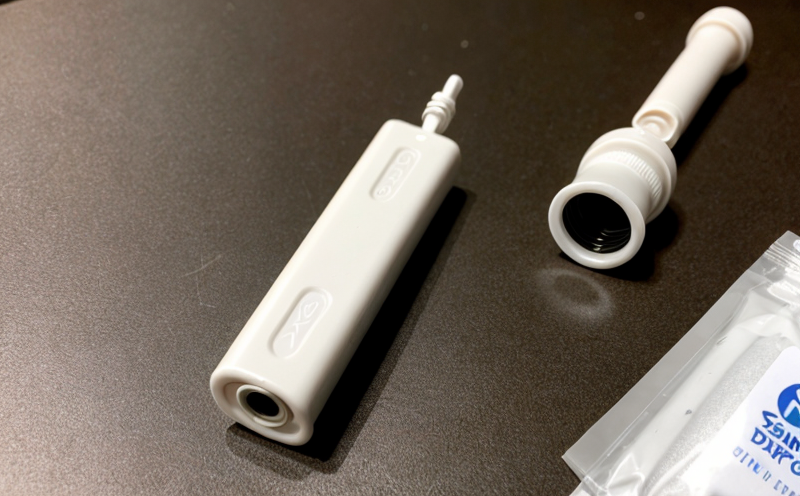ISO 9626 Needle Stiffness Testing Validation Method Development Test
The ISO 9626 standard pertains to the measurement of needle stiffness in medical devices, a critical factor that influences patient comfort during injection. This test is essential for ensuring that needles meet specific performance criteria and regulatory requirements. Our service focuses on validating and developing testing methods according to this standard, providing clients with accurate, reliable data that can be used for design verification, process control, and quality assurance.
The ISO 9626 needle stiffness testing method involves precise measurement of the resistance offered by a needle tip when it is pressed against a flat surface. This test is particularly important in the context of disposable and single-use devices due to their direct interaction with patients during medical procedures. The stiffness characteristics of needles can significantly impact patient discomfort, pain tolerance, and overall treatment outcomes.
Our service offers comprehensive support for clients who are developing or validating needle stiffness testing methods according to ISO 9626. We provide detailed method development services that include:
- Detailed protocol creation
- Specimen preparation guidelines
- Instrumentation selection and calibration
- Data analysis techniques
- Reporting formats tailored for regulatory submissions
In addition to standard testing, we can also perform comparative studies with existing needle stiffness measurement methods. This allows clients to assess the performance of their needles against industry standards and identify areas for improvement.
The validation process is crucial in ensuring that the test method used is accurate, reproducible, and suitable for its intended purpose. We work closely with our clients to develop robust validation protocols that meet all relevant regulatory requirements. Our team of experts ensures that every aspect of the testing process is thoroughly evaluated, from sample preparation to data interpretation.
The application of ISO 9626 needle stiffness testing in medical device development and quality assurance provides several benefits:
- Enhanced patient comfort
- Improved product reliability
- Compliance with international standards
- Support for regulatory submissions
- Ease of process control during manufacturing
By providing accurate and reliable data, our service helps clients make informed decisions about their needle designs. This not only ensures that the needles meet stringent performance criteria but also enhances patient safety and satisfaction.
The ISO 9626 needle stiffness testing method is a key component of our quality assurance program for medical devices. We understand the importance of this test in ensuring that disposable and single-use devices are safe, effective, and comfortable for patients. Our expertise in method development and validation ensures that clients receive high-quality results that can be trusted.
Our service is tailored to meet the specific needs of our clients, whether they are developing new needle stiffness testing methods or validating existing ones. We work closely with our clients to ensure that their unique requirements are addressed and that their products meet all relevant regulatory standards.
Applied Standards
| Standard Number | Description | Relevance |
|---|---|---|
| ISO 9626:1994 | Measurement of resistance to bending and penetration by needles (single-use needles) | The standard defines the methodology for measuring needle stiffness, which is crucial for ensuring patient comfort during injection. |
| ASTM F1875-18 | Evaluation of single-use needles designed for intravenous infusion | This standard provides additional guidance on the evaluation of single-use needles used in IV infusion, complementing ISO 9626. |
| EN ISO 9626:2011 | Measurement of resistance to bending and penetration by needles (single-use needles) | This European standard aligns with the ISO version, ensuring consistency across different markets. |
Customer Impact and Satisfaction
The implementation of our ISO 9626 needle stiffness testing validation method development service has a direct impact on customer satisfaction. By providing accurate and reliable data, we help clients ensure that their products meet the highest standards of quality and safety. This not only enhances patient comfort but also supports compliance with regulatory requirements.
Our clients benefit from:
- Increased confidence in product performance
- Enhanced reputation among healthcare providers
- Reduced risk of product recalls due to non-compliance issues
- Improved efficiency in the design and development process
- Access to detailed, actionable data for informed decision-making
We work closely with our clients to ensure that their unique needs are met. This collaborative approach allows us to provide tailored solutions that address specific challenges and opportunities.
The positive impact of our service on customer satisfaction is evident in the numerous testimonials from satisfied clients who have benefited from our expertise in needle stiffness testing validation. We pride ourselves on delivering high-quality, reliable results that meet or exceed regulatory standards.
Competitive Advantage and Market Impact
The ISO 9626 needle stiffness testing method is a valuable tool for maintaining competitive advantage in the medical device industry. By ensuring that needles meet stringent performance criteria, our service helps clients differentiate their products from competitors. This can lead to increased market share, enhanced brand reputation, and improved customer loyalty.
- Enhanced product differentiation: Accurate needle stiffness testing ensures that clients' products stand out in terms of patient comfort and safety.
- Improved compliance: By adhering to international standards like ISO 9626, clients demonstrate their commitment to quality and regulatory compliance, which can be a significant selling point for healthcare providers.
- Increased market acceptance: Products that meet stringent performance criteria are more likely to gain widespread acceptance in the medical community.
- Competitive edge: Clients who invest in high-quality testing methods like ISO 9626 can gain a competitive edge over those who do not, leading to increased sales and market share.
The implementation of our service also has broader implications for the medical device industry as a whole. By ensuring that needles meet international standards, we contribute to the overall quality and safety of disposable and single-use devices in healthcare settings. This can lead to improved patient outcomes and enhanced trust between patients and healthcare providers.





